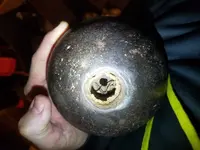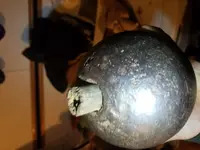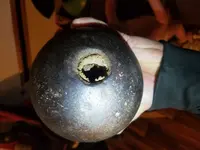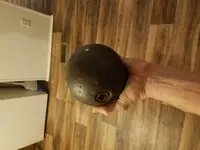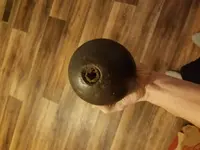You already know all (or most of) the following information... so it is mostly for other folks reading this post, because some of them don't already know it.
First and foremost:
ALL actual cannonballs were very carefully manufactured to be a "True-Sphere" ...meaning, as perfectly round as a glass marble, or a ball-bearing. Being out-of-round (even slightly egg-shaped, or with bumps, or a raised band, or a flat area) automatically disqualifies the "ball" from being a cannonball.
Quite literally,
millions of iron/steel balls have been manufactured for Civilian usage/purposes... never intended to be artillery projectiles. Some examples of non-artillery balls:
Mining-&-Stonemilling Industry rock-crusher balls (called Mill-balls)
Ornamental Ironwork balls (such as a gatepost-top)
Sports Shot Put balls
Counterweight balls.
So, we cannonball collectors had to find a 100%-reliable way to tell actual cannonballs from the various other kinds of iron balls. The answer is to consult Historical artillery data, which gives us the
very precise diameter and
very-exact weight of of every kind of cannonball ever used in battle in America.
Because super-precise measuring is crucially necessary, we "serious" collectors use super-precise tools. To measure the ball's weight, we use a digital Postal Shipping Scale, which measures in 1/10th-ounce graduations. You
cannot trust household bathroom weighing-scales, which are typically inaccurate by 5% -- or more.
For diameter, we use:
1- a Digital Caliper, which measures in (at least) 1/100th-of-an-inch increments.
2- if the ball is too large for a Digital Caliper, we use a Diameter-Tape (also called a Pi Tape).
If the ball is indeed an Artillery projectile (cannonball, grapeshot-ball, canister-ball), its precise measurements will match up (within a very few 100ths-inch and a few ounces) with one of the Artillery ball sizes specified by the Army and Navy Artillery Ordnance Departments in the historical records.
Creskol, your friend will need to do the super-precise diameter and weight measuring. If he needs instructions, send him to this Educational article:
SolidShotEssentialsMod
When he tells you the ball's very-exact diameter and weight measurements, go to the following webpage and look for a precise match-up. (The sizes given include Civil War, and some War-of-1812 and Revolutionary War artillery balls.) If there is no match-up, the ball is not a cannonball.
www.civilwarartillery.com/shottables.htm
For example, at the moment, the ball's diameter is reported to be 6 inches. According to the Historical cannonball size records, no 6.0-inch cannonball was ever used in an American battle. So, if its diameter really is 6.0-inches, it is not a cannonball. The two "nearest" actual cannonball sizes are .25-inch larger and .32-inch smaller than a 6.0-inch ball.
I notice that the photo seems to show some areas on it which have no rust, and other areas which are rusty. That's not a good sign. But we'll wait to see what its precise measurements tell us.



